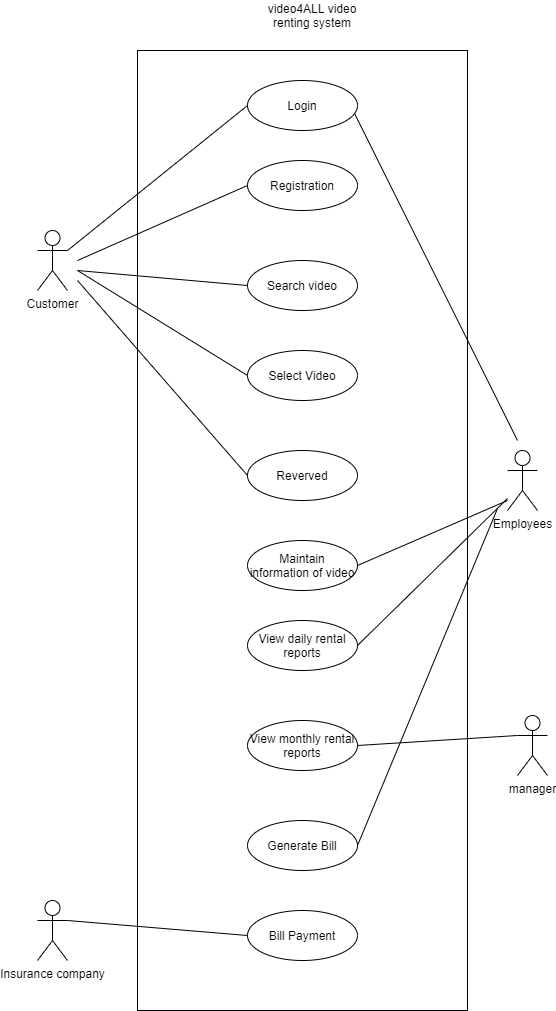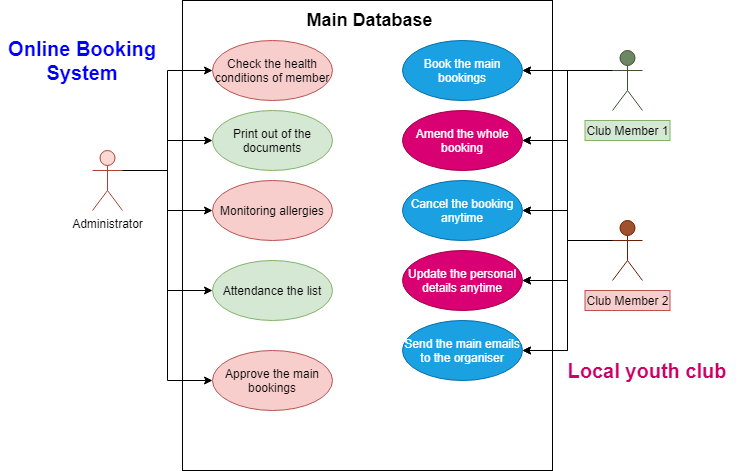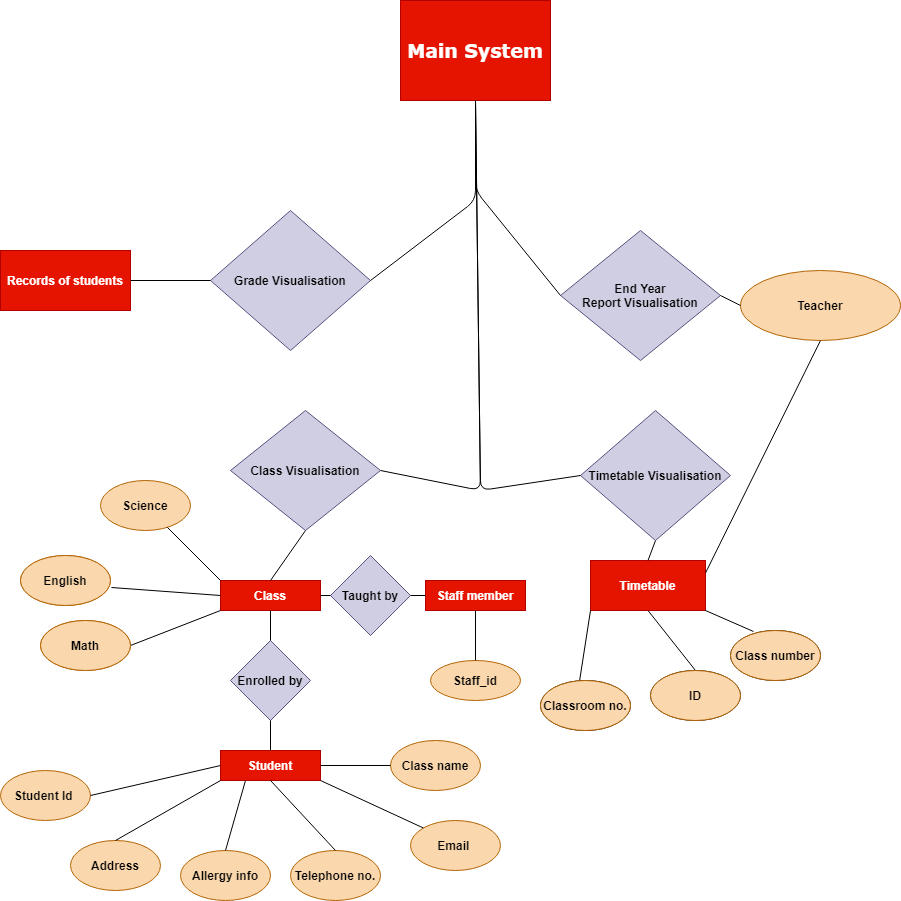CIS010-6 ASSIGNMENT SAMPLE – DATA MODELLING AND MANAGEMENT 2022
Question 1
Part A
Use-case Modelling techniques help to describe the functions which are high-level characters and also consist of scope into the system. The diagrams that are created in use-cases can easily be identified in the time of the interaction process between the actors and the systems. It helps to define and illustrate the requirements and contexts of the entire process or system; it is an essential part of the database management system. The things that are considered as the important categories in the database development process related to use-case diagrams are:
- It can establish the essential requirements which mainly involves the consultation techniques and also the agreement
- It helps to specify the system which produces the design documents and also helps to provide the “detailed descriptions” of the process of how the process really happened.
- After designing the use-case diagram the implementation process of the database development system will be started and it also consists of the environment on which the whole system will be operated.
Part B

Figure 1: Online Video Rental System
(Source: Draw.IO)
The above picture shows the use case scenario of the video rental system in which it can be seen that the main actors of the whole system are the insurance companies, managers, employees, and customers. This picture helps to provide the general knowledge of the rental service or the rental system which shows that the customers can log in to the store or website after proper authorization.
After the registration is done, the videos are searched easily and also it can be selected by the authorized users. Here managers are also interrelated to access and view the monthly rental reports and the bills and on the other hand, the employees can easily maintain each and every important piece of information related to rental reports on a monthly and daily basis (Kong et al., 2017).
It can also be shown that the main function of the insurance company is linked with only the case of bill payments. The essential function of the “Video rental system” is directly interrelated with the assigned tasks and with the help of this diagram the total design of the database can be easily made.
Part C

Figure 2: Online booking system
(Source: Draw.IO)
Here it can be seen that the online booking system of Local Youth Club is characterized where it shows that the administrator is able to monitor the club members by approving the main bookings. He or she can also maintain the attendance in the list and print the documents for checking the health conditions of the members, whereas the club members are able to book the essential characteristics like doctors’ visit, can also amend the whole booking system, and also cancel the booking anytime they want.
They can also update their personal system or handels their profile if anything important is required (Turco et al., 2019). Apart from that, they can send emails to the organizer also if anything needs to be changed. Here the main character is the Administrator who handles all the essential work.
Question 2
Part A
ER model or Entity-Relationship model is considered as the high-level data model that can help to define the relationship and data elements for the essential and specified system. This model helps to develop the “conceptual design” for the database management system by developing easy and simple data. The main components of the ER diagrams are the entity, attributes, and Relation.
Entity: It can be classified as the place, person, class, and object. It can be represented in the form of a rectangle in the ER diagram. The weak entity can also be there that mainly contains the key attributes on its own.
Attribute: Attributes are of four important types which are Derived attribute, multivalued attribute, composite attribute, and key attribute and these attributes can easily be defined for the property of the specified entity (Verma, 2021). Eclipse is used to show the attribute in the ER diagram.
Relationship: Like an attribute, a relationship consists of four important types which are a many-to-many relationship, many-to-one relationship, one-to-many relationship, and one-to-one relationship. It mainly helps to describe the essential relations between the entities. Rhombus and Diamond are used to represent “the relationship” in the E-R Diagram.
Part B

Figure 3: E-R Diagram
(Source: Draw.IO)
The above picture shows the Entity-relationship diagram where it can be seen that the red color rectangle box shows Entity, Eclipse is shown as the attribute and the rhombus is presented here as the Relationship. It shows basically the student record system of the Secondary school in Luton. This picture helps to make use of a database for storing all the essential and relevant information.
The student shown here can easily see the grades and print their timetable also at the end of the report. Each of the students is provided with the Uniqueq_ID number, email, address, and information of the allergies. In the case of entity-relationship of the timetable, it mainly includes the timetable ID, ID number, and class number.
In the case of the class identify the attributes available is shown here which mainly includes the subject of English, Science, and maths. The process of representation helps to show the consideration through the “diamond structure or rhombus structure” which basically helps to show the relationship between the class and staff members with the help of lesson deliveries (Fossatti et al., 2020).
On the other hand, a proper linkage is also shown in this picture that shows the relationship of the timetable to the class with the help of considering the observation of class and table’s features to deliver the main information in the form of two entities. In the last, it can be said that the teacher is available to see the final report with the help of considering the main timetable for the classes which is linked with the students by the enrollment process and also generated the grade of the students.
Question 3
Part A
SELECT * FROM MEMBER
Part B
CREATE TABLE MEMBER
(
member_id int NOT NULL PRIMARY KEY,
FirstName varchar(200),
ContactNumber varchar(200),
Surname varchar(200),
ContactEmail varchar(200),
Address varchar(200),
Current Boolean
);
Part C
The “SQL WHERE Clause” is mainly used to specify the essential condition during the time of fetching the single data from the single table and to join the data with the multiple tables. If this clause of the “given condition” is satisfied then it can only retain the specific value which is loaded in the table (Kim et al., 2017). This clause can be used in the DELETE and UPDATE statement that helps to examine the column.
Syntax
SELECT column1, column2, columnN
FROM table_name
WHERE [condition]
Taking an Example If in a row it is provided that a Customer a table is given which shows:
| ID | NAME | SALARY | ADDRESS |
| 1
|
John
|
30000.00
|
London
|
| 2 | Ross | 42100.00 | America |
| 3 | Joey | 23000.00 | Paris |
| 4 | Mon | 15000.00 | Sweden |
| 5 | Rach | 56000.00 | Irish |
If we give an SQL Command of :
SQL> NAME, SALARY
FROM CUSTOMERS
WHERE SALARY > 29000.00;
Then It will show the table in the form of
| Name | Salary |
| John | 30000.00
|
| Ross | 42100.00 |
| Rach | 56000.00 |
Part D
SELECT DISTINCT MemberID FROM Member
ORDER BY FirstName
Question 4
Part A
Data Normalization is the kind of design technique that helps to reduce the “data redundancy” and helps to eliminate undesirable characteristics such as Deletion of anomalies, updates, and insertion. Normalization mainly helps to divide a large table into smaller ones and helps to create links between their relationships.
In SQL the main purpose of that normalization is to eliminate the repetitive or redundant variables or data and to ensure that the data should be stored in a logical manner ( et alLi., 2018). There are five important types of Normalization techniques which are:
| Normalized Form | Description |
| 1NF | It is a relationship that helps to contain an atomic or unique value. |
| 2NF | All the nonkey attributes here are considered as fully dependent and functional on the 2NF Relation of the primary key. |
| 3NF | No such kinds of “transition dependencies” will exist in 3NF. |
| 4NF | It is also termed Boyce Codd’s normal form and it has no “multivalued” dependencies. |
| 5NF | Join dependencies will not occur in 5NF. |
Part B
Un-Normalized Form
| Subject | Format | Publication type | Publisher | Publisher country | Title | General Name | Author | Author nationality | Pages | Thickness | Price |
| Arts | Thesis | Binding | Godson | America | Colors are Beautiful | Ross Geller | Rachel Cruz | American | 264 | 5*6 | 12$ |
First Normalized Form (1NF)
| Subject | Publication type | Publisher | Publisher country | Title | General Name | Author | Pages | Thickness | Price |
| Science | Thesis | Ramsey | Newyork | IoT and Big Data | Dave Ramsey | Victoria Johnson | 544 | 6*3 | 25$ |
| Arts | Binding | Godson | America | Colors are Beautiful | Ross Geller | Rachel Cruz | 264 | 5*6 | 12$ |
| Laws | Thesis | Ayush | Sydney | Laws and Legislation of Australia | Singhania | Joey Mathew | 455 | 10*6 | 32$ |
Second Normalized Form (2NF)
Authors
| Subject | Format | Publisher | Title | Author | Author nationality | Price |
| Science | Thesis | Ramsey | IoT and Big Data | Victoria Johnson | Swedish | 25$ |
| Arts | Binding | Godson | Colors are Beautiful | Rachel Cruz | American | 12$ |
| Laws | Thesis | Ayush | Laws and Legislation of Australia | Joey Mathew | Irish | 32$ |
Books
| Title | Pages | Thickness |
| IoT and Big Data | 544 | 6*3 |
| Colors are Beautiful | 264 | 5*6 |
| Laws and Legislation of Australia | 455 | 10*6 |
Publishers
| Publisher | Publisher country | Publisher type |
| Ramsey | Newyork | Thesis |
| Godson | America | Binding |
| Ayush | Sydney | Thesis |
Third Normalized Form (3NF)
Subject
| Subject | Format | Title | Author | Price |
| Science | Thesis | IoT and Big Data | Victoria Johnson | 25$ |
| Arts | Binding | Colors are Beautiful | Rachel Cruz | 12$ |
| Laws | Thesis | Laws and Legislation of Australia | Joey Mathew | 32$ |
Author
| Author | Author nationality |
| Victoria Johnson | Swedish |
| Rachel Cruz | American |
| Joey Mathew | Irish |
Publisher
| Publisher | Publisher country |
| Ramsey | Newyork |
| Godson | America |
| Ayush | Sydney |
Book
| Title | General name |
| IoT and Big Data | Dave Ramsey |
| Colors are Beautiful | Ross Geller |
| Laws and Legislation of Australia | Singhania |
Pages
| Pages | Thickness
|
| 544 | 6*3 |
| 264 | 5*6 |
| 455 | 10*6 |
Format of Publisher
| Publisher Name | Format | Thickness | Publication Type |
| Ramsey | Thesis | 6*3 | Thesis |
| Godson | Binding | 5*6 | Binding |
| Ayush | Thesis | 10*6 | Thesis |
Reference List
Journals
Fossatti, F., Agugiaro, G., Olde Scholtenhuis, L. and Dorée, A., 2020. Data modeling for operation and maintenance of utility networks: Implementation and testing. ISPRS Annals of the Photogrammetry, Remote Sensing and Spatial Information Sciences, 6(4/W1), pp.69-76.
Kim, B.S., Kang, B.G., Choi, S.H. and Kim, T.G., 2017. Data modeling versus simulation modeling in the big data era: case study of a greenhouse control system. Simulation, 93(7), pp.579-594.
Kong, F., Ban, Y., Yin, H., James, P. and Dronova, I., 2017. Modeling stormwater management at the city district level in response to changes in land use and low impact development. Environmental Modelling & Software, 95, pp.132-142.
Li, A., Yang, X., Dong, H., Xie, Z. and Yang, C., 2018. Machine learning-based sensor data modeling methods for power transformer PHM. Sensors, 18(12), p.4430.
Turco, M.L., Calvano, M. and Giovannini, E.C., 2019. Data modeling for museum collections. International Archives of the Photogrammetry, Remote Sensing and Spatial Information Sciences, 42(2/W9).
Verma, M., 2021. Modeling Identity Management System Based on Blockchain Technology. Journal homepage: www. ijrpr. com ISSN, 2582, p.7421.
Know more about UniqueSubmission’s other writing services:


Your article helped me a lot, is there any more related content? Thanks! https://accounts.binance.com/uk-UA/register?ref=WTOZ531Y
I am currently writing a paper that is very related to your content. I read your article and I have some questions. I would like to ask you. Can you answer me? I’ll keep an eye out for your reply. https://technomondo.xyz/profile.php?from=space&mod=space&username=delia_mcfarlane.189541